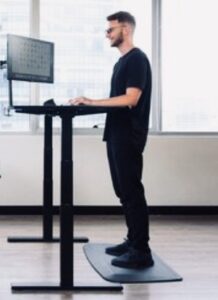Have you thought about getting a standing desk for your home office? Did all your co-workers have them before? These days, so many nine-to-fivers are opting to switch out traditional work stations for  standing desks. (BTW, these are desks that can be raised or lowered. They give you the option of standing or sitting throughout the day.)
standing desks. (BTW, these are desks that can be raised or lowered. They give you the option of standing or sitting throughout the day.)
These standing desks became popular for a reason. So many people in this country struggle with their weight. And that's partly because of their lack of activity.
That's why many people thought standing desks were great. They could solve the problem of all-day sitting. But, unfortunately, standing desks bring individuals a whole new set of problems. Because, as it turns out, standing desks are linked to increases in foot and back pain. They can also increase your risk of developing varicose veins. To better understand the risks of a standing desk, let’s explore the pros and cons of each desk option.
Have you heard that sitting is the new smoking? That’s right, some health experts have said that it’s worse for your health to sit all day than to smoke a pack of cigarettes. Extended periods of sitting have been linked to an increased risk of both heart and kidney disease. Not surprisingly, sitting has also been shown to increase the odds of gaining weight. And, as we already know, being overweight contributes to heart disease, type 2 diabetes and certain cancers. Some researchers even suggest that increasing your exercise level won’t completely combat the effects of entire days spent sitting. That's why people started falling for standing desks.
Here's some unwanted news. Even if you get your boss to approve a standing desk, or spring for one on your own, your health woes may not be over. Standing desks have been known to cause back and foot pain. And that's not all. Extended periods of standing can leave you feeling tired and less able to concentrate.
Plus, getting to the point of this blog, standing desks increase your risk of DVTs (deep vein thrombosis) and those lovely, bulging varicose veins we all love to hate. Why is that the case? Standing all day overworks your back, leg and feet muscles as you struggle to maintain one position. And, to find out why all day standing can cause spider veins, just keep reading!
The veins in your lower legs have to fight gravity to get your blood to flow up your body to your heart. As you age, or when you put too much pressure on those veins, they can weaken or sustain damage. That already makes it harder for blood to get moving.
As a result, blood pools in your veins and the vessels swell. This is when you usually notice spider veins. Your varicose vein risk increases when it becomes harder for your blood to flow to your heart. Weight gain, tight clothes and—you guessed it—long periods on your feet—make it harder for blood to flow. That’s why standing desks, and jobs like construction work or nursing that keep you on your feet, make you more likely to develop spider veins.
Since neither option is perfect, a standing desk is still a great choice. Because it moves up and down, you can alternate between periods of sitting and time spent standing. But how often should you switch positions?
Unfortunately, not everyone agrees on this front. Experts recommend changing positions anywhere between every 20, 30 or 60 minutes. And some get more specific about standing desks. They say you should not stand up to work for more than 10 minutes out of every hour. You can also invest in an anti-fatigue mat to use when you're standing up at your desk. This can help take some pressure off your lower legs and feet.
If you follow these guidelines, you can minimize your risk of standing or sitting too much. It’s also a great idea to step away from your desk for quick walking breaks throughout the day. Even small bursts of movement can help keep your blood flowing as it should.
When you're not at work, make sure to exercise regularly. Workouts like walking or yoga can boost your blood flow, encouraging circulation out of your legs. At home and on the job, choose your clothes carefully. Avoid outfits that are tight at the waist or legs, like Spanx.
If you're carrying extra weight, losing a few pounds can help boost your circulation. If you're a smoker, now's the time to quit. Finally, if your standing desk is triggering your spider veins, consider wearing compressions socks. And at the end of the day, be sure to elevate your feet for at least 15 minutes, to help get blood flowing out of your legs.
Making the switch to a standing desk can be life changing—as long as you know the risks and take the appropriate precautions. Still with proper care, you can almost certainly enjoy this innovative office feature without the fear of destroying your vein health. And if you have concerns about sitting, standing and your vein health, come in for a diagnostic vein scan. We'll let you know if that standing desk is a good idea or not!

Scheduling
Please contact our dedicated specialists to schedule a consultation today.
2024 Texas Endovascular. All rights reserved. Website Design by Healthcare Success